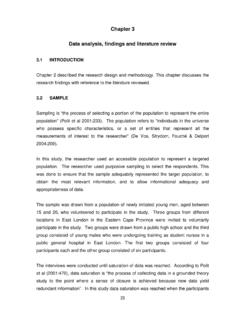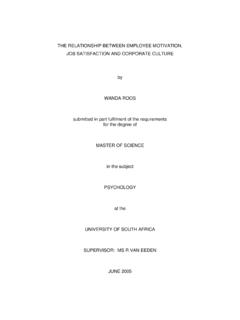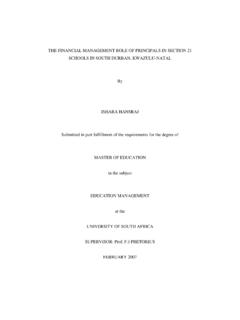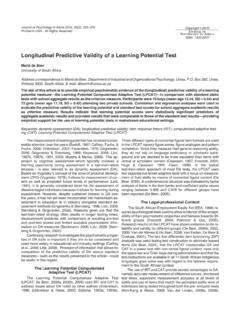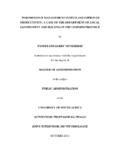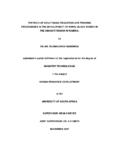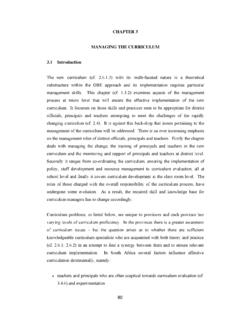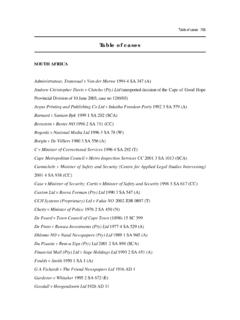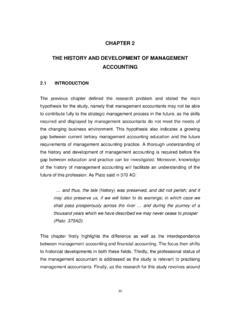Transcription of CHAPTER 4 Research Methodology and Design
1 CHAPTER 4. Research Methodology and Design Introduction All Research is based on some underlying philosophical assumptions about what constitutes 'valid' Research and which Research method(s) is/are appropriate for the development of knowledge in a given study. In order to conduct and evaluate any Research , it is therefore important to know what these assumptions are. This CHAPTER discusses the philosophical assumptions and also the Design strategies underpinning this Research study. Common philosophical assumptions were reviewed and presented; the interpretive paradigm was identified for the framework of the study.
2 In addition, the CHAPTER discusses the Research methodologies, and Design used in the study including strategies, instruments, and data collection and analysis methods, while explaining the stages and processes involved in the study. The Research Design for this study is a descriptive and interpretive case study that is analysed through qualitative methods. Questionnaires were used to evaluate participants' WebCT skills (before the course starts) and to determine their levels of satisfaction in the course (at the end of the case study).
3 A descriptive statistical method was used to analyze the student satisfaction survey. Participant observation, face-to-face interviews, focus-group interviews, questionnaires, and member checking were used as data collection methods. Furthermore, the justification for each of the data collection methods used in the study was discussed. Finally, in order to ensure trustworthiness of the Research , appropriate criteria for qualitative Research were discussed, and several methods that include member checks, peer reviews, crystallisation and triangulation were suggested and later employed.
4 The CHAPTER closed with a diagrammatic representation of the major facets of the envisaged framework for the Research Design and development of the study, and a discussion on the project management approach envisaged for this study. CHAPTER 4: Research Methodology and Design 292. Research Paradigm According to TerreBlanche and Durrheim (1999), the Research process has three major dimensions: ontology1, epistemology2 and methodology3. According to them a Research paradigm is an all-encompassing system of interrelated practice and thinking that define the nature of enquiry along these three dimensions.
5 The term paradigm originated from the Greek word paradeigma which means pattern and was first used by Thomas Kuhn (1962) to denote a conceptual framework shared by a community of scientists which provided them with a convenient model for examining problems and finding solutions. Kuhn defines a paradigm as: an integrated cluster of substantive concepts, variables and problems attached with corresponding methodological approaches and tools . According to him, the term paradigm refers to a Research culture with a set of beliefs, values, and assumptions that a community of researchers has in common regarding the nature and conduct of Research (Kuhn, 1977).
6 A paradigm hence implies a pattern, structure and framework or system of scientific and academic ideas, values and assumptions (Olsen, Lodwick, and Dunlop, 1992:16). Ontological and epistemological aspects concern what is commonly referred to as a person's worldview which has significant influence on the perceived relative importance of the aspects of reality. Two possible worldviews are: objectivistic and constructivist. These different ways of seeing the world have repercussions in most academic areas; yet, none of theses views is considered to be superior to the other.
7 Both may be appropriate for some purposes and insufficient or overly complex for other purposes. Also a person may change his/her view depending on the situation. For example, this study makes use of elements from both views and considers them as complementary. According to Lather (1986a: 259) Research paradigms inherently reflect our beliefs about the world we live in and want to live in. Based on this belief, Guba and Lincoln (1994) distinguish between positivist, post-positivist and postmodernist enquiry, grouping postmodernism and post-structuralism within critical theory'.
8 The nature of 1. The term Ontology refers to a branch of philosophy concerned with articulating the nature and structure of the world (Wand and Weber, 1993, p. 220). It specifies the form and nature of reality and what can be known about it. 2. Epistemology refers to the nature of the relationship between the researcher (the knower) and it denotes (Hirschheim, Klein, and Lyytinen, 1995) the nature of human knowledge and understanding that can possibly be acquired through different types of inquiry and alternative methods of investigation.
9 " (p. 20). 3. Methodology refers to how the researcher goes about practically finding out whatever he or she believes can be known. CHAPTER 4: Research Methodology and Design 293. reality assumed by positivism is realism, whereby a reality is assumed to exist; in contrast, post-positivism assumes that this reality' is only imperfectly and probabilistically apprehendable' (Guba and Lincoln, 1994, p. 109). Post-positivism is viewed as a variant of the former positivism, but they are both objectivist.
10 Critical theory adopts a more transactional and subjectivist epistemology where the investigator and the investigated object are assumed to be interactively linked, with the values of the investigator .. inevitably influencing the inquiry' (Guba and Lincoln, 1994, p. 110). Whereas the aim of positivist and post-positivist enquiry is explanation, prediction and control, the aim of critical theory is critique and emancipation (Willmott, 1997). Gephart (1999) classified Research paradigms into three philosophically distinct categories as positivism, interpretivism and critical postmodernism.
